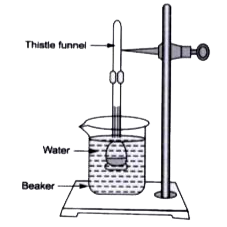Of what importance is the study of leaf morphology for a physiologist ?
Step-by-Step Text Solution:
1. Introduction to Leaf Morphology:
- Leaf morphology refers to the study of the form and structure of leaves. Understanding leaf morphology is crucial for physiologists as it provides insights into plant functions and adaptations.
2. Identification and Description of Plants:
- The study of leaf morphology aids in the identification and classification of different plant species. Physiologists can describe and categorize plants based on their leaf characteristics, such as shape, size, and arrangement.
3. Understanding Plant Growth Conditions:
- Leaf morphology reveals specific characteristics that indicate the conditions necessary for a plant's growth. For example, the orientation of leaves towards light (phototropism) can inform physiologists about the plant's light requirements.
4. Maximizing Crop Productivity:
- By understanding leaf morphology, physiologists can manipulate environmental conditions to enhance plant growth. This knowledge can lead to increased crop yields and productivity, which is essential for agriculture.
5. Determining Physiological Maturity:
- The shape and size of leaves can indicate the physiological maturity of a plant. For instance, in cotton plants, the size of the leaves can signal whether the plant is ready for photosynthesis, which is critical for its development.
6. Understanding Heterophylly:
- Some plants exhibit heterophylly, where they have different leaf shapes at different growth stages or in different environments. Studying leaf morphology helps physiologists understand these adaptations and how they benefit the plant in varying conditions.
7. Horticultural Value:
- In horticulture, the aesthetic value of plants with diverse leaf shapes and sizes is significant. Understanding leaf morphology can enhance ornamental plant selection and breeding.
8. Conclusion:
- Overall, the study of leaf morphology is vital for physiologists as it provides essential information about plant identification, growth conditions, productivity, maturity, adaptations, and horticultural applications.
- Leaf morphology refers to the study of the form and structure of leaves. Understanding leaf morphology is crucial for physiologists as it provides insights into plant functions and adaptations.
- The study of leaf morphology aids in the identification and classification of different plant species. Physiologists can describe and categorize plants based on their leaf characteristics, such as shape, size, and arrangement.
- Leaf morphology reveals specific characteristics that indicate the conditions necessary for a plant's growth. For example, the orientation of leaves towards light (phototropism) can inform physiologists about the plant's light requirements.
- By understanding leaf morphology, physiologists can manipulate environmental conditions to enhance plant growth. This knowledge can lead to increased crop yields and productivity, which is essential for agriculture.
- The shape and size of leaves can indicate the physiological maturity of a plant. For instance, in cotton plants, the size of the leaves can signal whether the plant is ready for photosynthesis, which is critical for its development.
- Some plants exhibit heterophylly, where they have different leaf shapes at different growth stages or in different environments. Studying leaf morphology helps physiologists understand these adaptations and how they benefit the plant in varying conditions.
- In horticulture, the aesthetic value of plants with diverse leaf shapes and sizes is significant. Understanding leaf morphology can enhance ornamental plant selection and breeding.
- Overall, the study of leaf morphology is vital for physiologists as it provides essential information about plant identification, growth conditions, productivity, maturity, adaptations, and horticultural applications.
Topper's Solved these Questions
- MORPHOLOGY OF FLOWERING PLANTS BOOK - ICSECHAPTER - MORPHOLOGY OF FLOWERING PLANTS EXERCISE - Test Your Progress (HOTS)
4 Videos
- MORPHOLOGY OF FLOWERING PLANTS BOOK - ICSECHAPTER - MORPHOLOGY OF FLOWERING PLANTS EXERCISE - Ncert Exercises with Answers
25 Videos
- MORPHOLOGY OF FLOWERING PLANTS BOOK - ICSECHAPTER - MORPHOLOGY OF FLOWERING PLANTS EXERCISE - Test Your Progress (Very Short Answer Type Questions )
35 Videos
- MORPHOLOGY AND ANATOMY OF DIFFERENT SYSTEM OF COCKROACH BOOK - ICSECHAPTER - MORPHOLOGY AND ANATOMY OF DIFFERENT SYSTEM OF COCKROACH EXERCISE - Long Answer type Questions
6 Videos
- NEURAL CONTROL AND CO-ORDINATION BOOK - ICSECHAPTER - NEURAL CONTROL AND CO-ORDINATION EXERCISE - NCERT EXERCISES WITH ANSWER (DIFFERENTIATE BETWEEN)
11 Videos
Similar Questions
Morphology is the study of
View SolutionWhat is the study of animals called?
View SolutionWhat imparts green colour to a leaf?
View SolutionWhat is the true about a monocot leaf?
View SolutionGametes that are similar in morphology.
View SolutionWhat is the importance of heavy water ?
View SolutionWhat are the adaptations of leaf for photosynthesis ?
View SolutionTaxonomy related to morphology is
View Solutionwhat differentiates a dicot leaf from monocot leaf
View SolutionGiven alongside is the diagram of an apparatus set-up to study a very important physiological process.

Is sugar solution hypotonic or hypertonic?
View Solution
